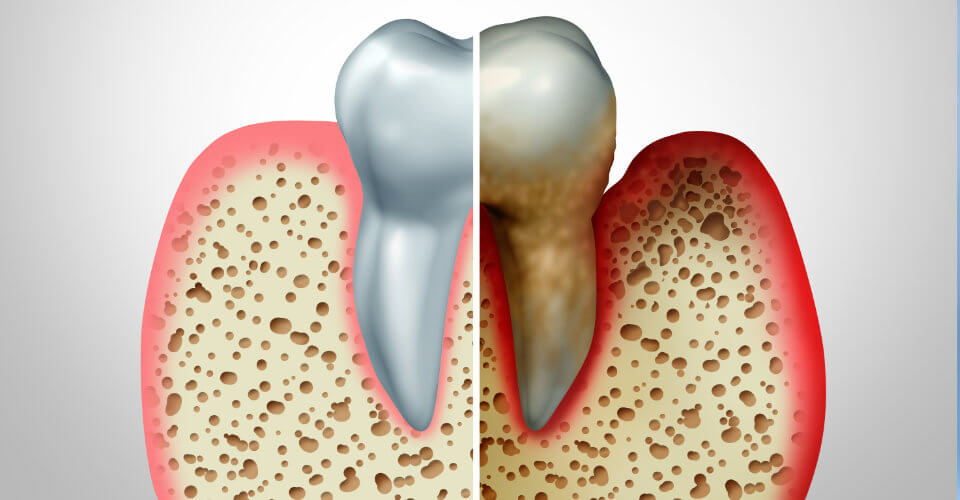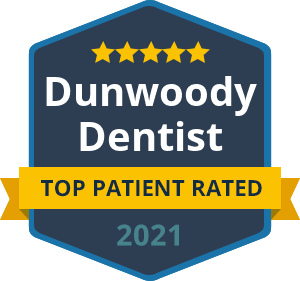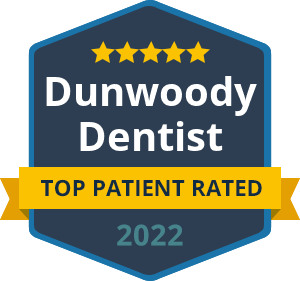Gum disease is an essential piece of your overall health, and if left untreated, can lead to problematic issues you want to avoid.
According to the CDC, as many as 47.2% of Americans (64.7 million aged 30 and older) have gum disease. For people over the age of 65, this number rises to 70%. Gum disease is the leading cause of tooth loss and is associated with other diseases like diabetes and heart disease.
Schedule Your Appointment!
Book AppointmentGum
Disease
Treatment
TABLE OF CONTENTS
- Types of Gum Disease
- Gingivitis
- Periodontitis
- Risk Factors
- Symptoms
- Gum Disease and Other Diseases
- DIABETES
- HEART DISEASE
- OTHER DISEASES
- Comprehensive Periodontal Evaluation (CPE)
TYPES OF GUM DISEASE
- Gingivitis
- Gingivitis is inflammation of the gums. It is the first phase of periodontal disease. It occurs when plaque and bacteria from the foods we eat are not removed from the teeth. These foreign bodies cause an immune response that consists of bleeding, swelling, redness and pain. Gingivitis is completely reversible with professional hygiene and proper home care. However, if it isn't treated, it can progress to more advanced stages. Gingivitis is a precursor to bone loss, which defines periodontal disease (periodontitis). Other factors can contribute to gingivitis. Systemic diseases such as heart disease, diabetes, cancer or HIV can exacerbate the condition. Pregnancy or puberty can cause hormone changes that also aggravate the gingiva. Smoking, medication and other exogenous factors can affect the immune response to gingivitis as well.
- Periodontitis (Periodontal Disease)
- Over time, the plaque and bacteria that collect around the teeth start to damage the underlying bone. This is known as periodontal disease. As periodontitis progresses, larger and larger "pockets" form in the gums around the teeth. Bacteria grow in this area, causing more bone destruction, bad breath and eventually tooth loss. This can be a completely painless process until it is too late. Regular dental exams are required to measure the depth of these pockets and ensure that they are not progressing. Once periodontal disease is diagnosed, gum infection therapy is required as well as more frequent dental visits (every three months).
RISK FACTORS
Although plaque is the primary cause of gum disease, it can be exacerbated by these other risk factors:
- Age
- The old saying "getting long in the tooth" comes from the fact that periodontal disease is common with age. Studies show that around 70% of people over 65 have periodontitis. Since periodontitis has been shown to weaken the immune system and contribute to other system diseases, it must be treated in the older population to ensure total body health.
- Smoking/Tobacco Use
- In addition to causing lung cancer, tobacco use causes periodontal disease to progress faster than usual.
- Medications
- Some medications can cause dry mouth and hormonal changes, which may worsen periodontal disease.
- Clenching or Grinding Your Teeth (Bruxism)
- Clenching or grinding your teeth can put excess force on the supporting tissues of the teeth and could speed up the rate at which these periodontal tissues are destroyed.
- Stress
- Stress has shown to weaken our immune system, which is partly responsible for fighting off periodontal disease.
- Genetics
- Research has shown that some people are predisposed to developing gum disease faster than others. These people require more aggressive and consistent professional treatment.

SYMPTOMS
Gum disease isn’t painful. However, as it advances, it can lead to more and more symptoms, and eventually, tooth loss.
Symptoms of gum infection include:
- Bad Breath
- Bleeding while brushing or flossing
- Inflamed (red) gums that can be swollen or tender
- Gum recession and root exposure
- Teeth that wiggle or shift
- Pus
The MOUTH-BODY CONNECTION
Research shows that inflammation and bacteria in the mouth are linked to other diseases in the body. Many studies suggest that treating gum disease can help the immune system to fight off other diseases.
- Diabetes
- Periodontal disease has been shown to interact with diabetes. It can contribute to uncontrolled blood sugar and diabetic complications. It is also clear that diabetic patients are more likely to develop gum disease. Periodontal therapy can, therefore, help improve the immune system and, in turn, improve diabetes complications.
- Heart Disease and Strokes
- Research indicates that gum disease increases the risk of heart disease due to the adverse effects of inflammation in the mouth on the rest of the body. Other studies show that people who suffer strokes are more likely to have oral infections.
PERIODONTAL EVALUATION
We recommend a yearly periodontal evaluation to screen for the signs and symptoms of gum disease. This consists of measuring the pocket depth around the gums and looking for signs of inflammation or poor hygiene. We also use x-rays to see if there is any bone loss.
TREATMENT
- Preventative Cleaning (Prophylaxis)
- Preventative cleaning is a cleaning that is done for patients with a healthy mouth. It consists of cleaning in and around the teeth and then polishing with prophy paste. Oral hygiene instructions are given if needed for any problem areas.
- Gingival Cleaning
- Gingival cleaning is a cleaning that is done for patients with gingivitis (inflammation of the gums). It consists of cleaning in and around teeth as well as disinfection with antibiotic rinses. We will then make sure you understand what areas have inflammation and how to clean them properly.
- Gum Infection Therapy
- Gum infection therapy is utilized when signs of periodontitis or bone loss have occurred and consists of several steps. After proper diagnosis, we will remove all plaque and bacteria both above and below the gums. We will also scale, smooth and polish the roots, so they don't continue to collect plaque. Next, we will disinfect the areas using antibiotic rinses. We will then focus on oral hygiene instruction and how to clean and maintain the teeth properly.
- Re-evaluation
- The most crucial component of success is home care. This is why we recommend re-evaluation six weeks after gum infection therapy to make sure that you aren't missing any areas with your cleaning tools. Our hygienist will show you where you are missing and what tools you can use to clean.
- Frequency of Cleaning
- For patients that have had periodontal disease or bone loss, research recommends that we see you every three months for an evaluation and cleaning. This frequency has been shown to be about the time it takes to prevent further bone loss and the advancement of the disease. However, everyone's response is different as there are varying degrees of home care compliance.








